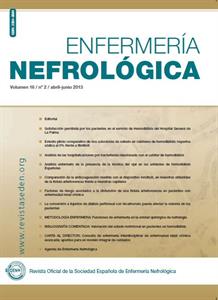Contenido del artículo principal
Resumen
Uno de los más importantes y frecuentes problemas de pacientes en hemodiálisis y factor de riesgo de mortalidad, es la malnutrición calórica proteica sin que exista un consenso para evaluarla. Se consideran causas de malnutrición la infl amación, el hipercatabolismo asociado al procedimiento dialítico, las situaciones comórbidas y la reducción en la ingesta calórico protéica. Por otra parte, la asociación de malnutrición, inflamación y aterosclerosis constituye un síndrome (MIA) que se asocia a una elevada morbilidad y mortalidad de causa cardiovascular.Se han propuesto diferentes métodos para valorar el estado nutricional del paciente entre los que destacan además de los parámetros antropometricos y analíticos, la Subjective Global Assessment (SGA), el score de mal-nutrición infl amación, la absorciometría dual energética de rayos X, así como el análisis mediante bioimpedancia espectroscópica (BIS), pero ninguno se ha aceptado individualmente como método único de referencia. Aún así, en los últimos años, se ha extendido en las unidades de diálisis el uso de la BIS. Este es un método objetivo, inocuo, barato y reproducible para evaluar la composición corporal y el estado de hidratación, pudiendo obtener parámetros nutricionales que se relacionen con otros parámetros considerados buenos marcadores de la nutrición.
Palabras clave
Detalles del artículo
Aviso de derechos de autor/a
© Los autores ceden de forma no exclusiva los derechos de explotación de los trabajos publicados y consiente en que su uso y distribución se realice con la Licencia Creative Commons Atribución - No comercial 4.0 Internacional (CC BY-NC 4.0). Puede consultar desde aquí la versión informativa y el texto legal de la licencia. Esta circunstancia ha de hacerse constar expresamente de esta forma cuando sea necesario.




